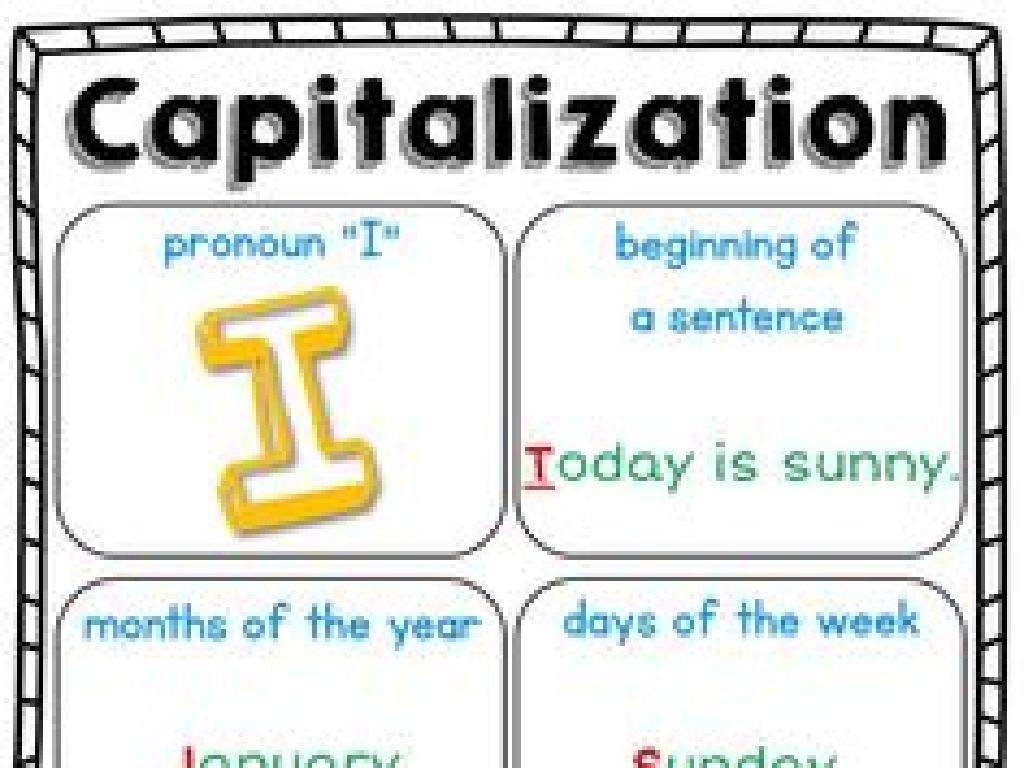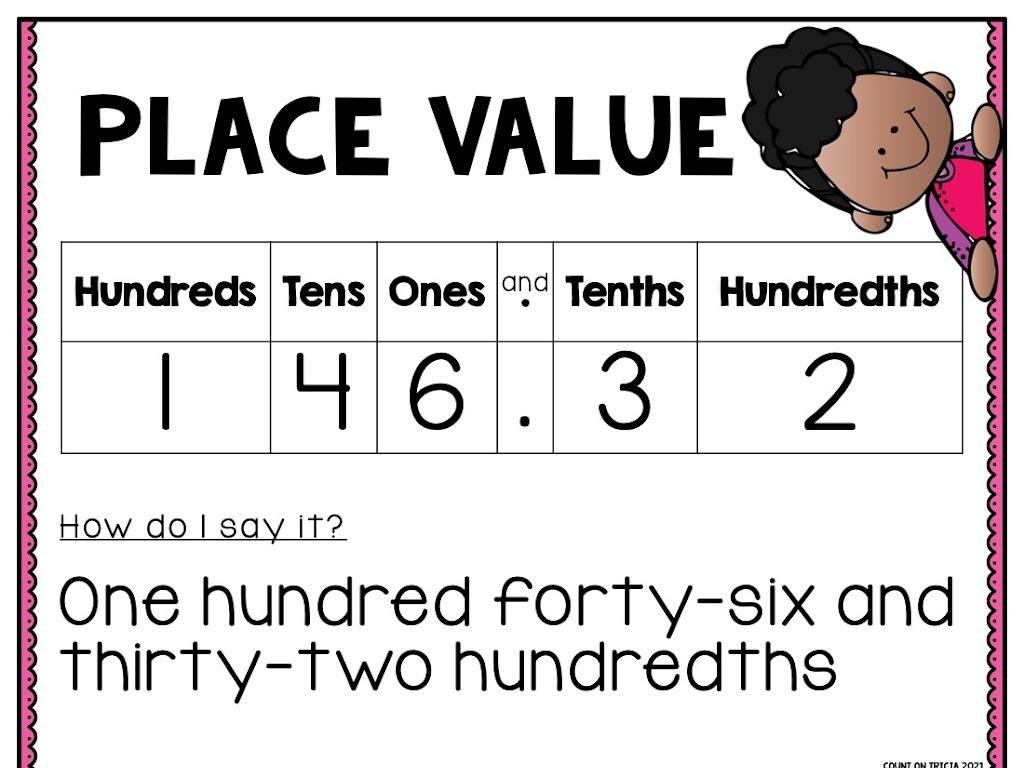Calculate Density
Subject: Science
Grade: Fifth grade
Topic: Matter And Mass
Please LOG IN to download the presentation. Access is available to registered users only.
View More Content
Exploring Density in Matter and Mass
– Matter and mass basics
– Everything around us is matter, and mass is how much there is.
– Define density
– Density tells us how tightly packed matter is in an object.
– Density formula
– Use the formula: Density = Mass ÷ Volume.
– Density in everyday objects
– Compare a rock and a sponge – both have mass, but different densities.
|
Begin the lesson by discussing the concept of matter and mass, emphasizing that all physical objects have mass. Introduce density as a measure of how much mass is contained in a given volume. Explain the formula for calculating density and ensure students understand each component of the formula. Use relatable examples, such as comparing the density of a rock to that of a sponge, to illustrate that objects of the same size can have different densities due to their mass and volume. Encourage students to think of other examples and to consider how density affects whether objects sink or float in water.
Exploring Matter and Its Properties
– Matter: Everything is made of it
– Matter forms: solids, liquids, gases
– Common states of matter we see daily
– Matter has mass and occupies space
– Why do things weigh something and fill containers?
– Understanding matter is key in science
|
This slide introduces the concept of matter, which is a fundamental idea in science and forms the basis for understanding density. Matter is essentially everything that makes up the world around us and can be observed in three primary states: solid, liquid, and gas. Emphasize that matter is characterized by having mass and taking up space. This understanding will be crucial as students move on to learn how to calculate the density of different objects, which is a measure of how much mass is contained in a given volume. Engage the students by asking them to think of examples of each state of matter in their everyday lives and to consider why understanding matter is important.
Mass vs. Weight: Understanding Density
– Mass: amount of matter
– Mass stays the same everywhere, unlike weight.
– Weight: gravity’s force
– Weight changes with gravity, not mass.
– Measuring mass in grams
– Use a scale to measure mass in grams or kilograms.
– Mass vs. Weight in density
– Density formula: Density = Mass/Volume. Mass is not weight.
|
This slide aims to clarify the difference between mass and weight, which are often confused. Mass is a measure of how much matter an object contains and remains constant regardless of location. Weight, on the other hand, is the force exerted by gravity on that mass and can change depending on where the object is in the universe. Emphasize that for calculating density, we use mass, not weight. Provide examples of objects with the same mass but different weights on Earth and the Moon due to gravity’s variance. This will help students understand why astronauts feel lighter on the Moon. Encourage students to think about how objects with the same volume can have different masses and hence different densities.
Introduction to Density
– What is density?
– Density measures how much stuff is in a space.
– Density formula: Density = Mass ÷ Volume
– To calculate: divide the mass (how heavy) by the volume (how big).
– High density vs. Low density
– Objects with more density are heavier and sink.
– Density in water: Sink or Float?
– Objects with less density are lighter and float.
|
This slide introduces the concept of density, which is a fundamental property of matter. It’s important for students to understand that density is a measure of how tightly mass is packed within a given volume. The formula for calculating density is a simple division of mass by volume. Use examples like a rock (high density) and a sponge (low density) to illustrate why some objects sink in water while others float. Encourage students to think of other examples of objects that sink or float and discuss why that might be in terms of density. This will help them grasp the concept of density in a tangible way.
Calculating Density
– Density requires mass and volume
– Measure mass using a scale
– Use a balance to find how heavy an object is
– Measure liquid volume with a cylinder
– Fill the cylinder and read the level the liquid reaches
– Calculate solid volume by dimensions
– Multiply length, width, and height for objects like a box
|
Density is a fundamental concept that describes how much mass is contained in a given volume. Start by explaining that density can be thought of as how tightly packed the matter in an object is. To find the density of an object, students must first understand how to measure mass and volume. Mass is measured using a scale, and it’s important to ensure students know how to read the scale correctly. Volume for liquids is measured with a graduated cylinder, and students should practice reading the meniscus. For regular-shaped solids, volume is found by measuring the object’s dimensions and using the formula for volume (length × width × height). Have students practice with different objects and record their measurements. This will prepare them for the next step of calculating density using the formula density = mass/volume.
Density in Action: Float or Sink?
– Why do objects float or sink?
– Comparing object & water density
– Objects less dense than water float, others sink
– Ice floats on water: a case study
– Ice is less dense than liquid water, so it floats
– Density’s role in buoyancy
|
This slide aims to help students understand the concept of density and its effect on whether objects float or sink in water. Begin by posing the question of why certain things float while others do not, prompting students to think about their experiences with floating and sinking objects. Explain that an object’s density compared to the density of water determines its buoyancy. Use the example of ice floating on water to illustrate this point, as ice is less dense than liquid water. Encourage students to think of other examples and to predict whether objects will float or sink based on their densities. This will help solidify their understanding of density in a tangible and interactive way.
Let’s Practice Calculating Density!
– Understand the density formula
– Calculate density with an example
– Use the block example: 200g mass and 50cm³ volume
– Density equals mass divided by volume
– Remember: Density = Mass ÷ Volume
– Block’s density: 4g/cm³
– This means our block is quite dense!
|
This slide is aimed at helping students practice the concept of density, which is a measure of how much mass is contained in a given volume. Start by explaining the formula for density, which is Density = Mass ÷ Volume. Use the example of a block with a mass of 200 grams and a volume of 50 cubic centimeters to illustrate the calculation. Show the students step by step how to divide the mass by the volume to find the density, which in this case is 4 grams per cubic centimeter. Emphasize that this number tells us the block is relatively dense. Encourage students to find objects at home to measure and calculate density as a practical application of what they’ve learned.
Class Activity: Density Discovery
– Measure object density
– Predict floating or sinking
– Will it float or sink in water? Make a guess!
– Record and observe
– Use a scale for weight, a graduated cylinder for volume
– Share findings with class
|
In this hands-on activity, students will apply their knowledge of density by measuring and calculating the density of various objects. Provide a variety of objects with different shapes, sizes, and materials. Students will use scales to measure the mass and graduated cylinders to determine the volume of objects. They will then calculate the density using the formula density = mass/volume. Encourage them to predict whether each object will float or sink when placed in water, based on their density calculations. After conducting the experiment, students should record their observations and be prepared to discuss their findings. This activity will help solidify their understanding of density and buoyancy. Possible objects for the activity could include a rubber ball, a rock, a piece of wood, and a metal spoon.
The Wonders of Density
– Density: Float or Sink
– Objects with lower density than water float, others sink.
– Density’s Real-World Uses
– Used in cooking, ship design, and more.
– Congratulations, Young Scientists!
– Continue Your Exploration
– Keep observing and questioning how things work!
|
As we wrap up our lesson on density, it’s important to emphasize the practical applications of this concept. Density explains why some objects float in water while others sink, which is a principle that can be observed in everyday life. Understanding density has real-world implications in various fields such as culinary arts, where it affects how ingredients mix, or in engineering, particularly in shipbuilding where it ensures vessels stay afloat. Congratulate the students on their hard work and encourage their natural curiosity. Inspire them to continue exploring and understanding the physical principles that govern our world, reinforcing the idea that science is a part of everyday life.




